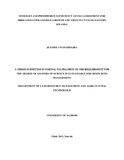Nitrogen and Phosphorus sufficiency levels assessment for irrigated lowland Rice growth and yield in Cyunuzi, Eastern Rwanda
Abstract
The present study was undertaken in Cyunuzi (Eastern Rwanda) paddy field using "upland 26"
variety with the objective of assessing the sufficiency levels of nitrogen and phosphorus in order
to develop tools for fertilizer recommendation for optimal rice growth and yields.
The study was carried out as a three replicate 4x3factorial experiment laid in a Randomized
Complete Block Design. The treatments included four nitrogen (urea) levels ( 0, 40, 80 and
120kg N/ha), three phosphorus (single super phosphate) levels( 0, 34 and 70kg P20s/ha) and
their combinations. All experimental plots received potassium fertilizer (KCl) at the rate of 34kg
K20/ha. The soil in experimental plots was analyzed for total N, available P (Bray I),
exchangeable K, organic C, CEC, pH and bulk density prior to treatments application and for
pH, total N and available P at the harvest. The crop (Oryza sativa) leaves were analyzed for total
nitrogen and phosphorus at the flowering stage. Plant height, tiller number, leaf area and the
above-ground biomass were measured as growth parameters whereas the yield components
including the number of panicles per plant, total grain per panicle, filled grain per panicle,
empty grain per panicle, weight of 1000 grains, the yield per plant and the total yield per plots
were determined at harvest.
The results showed that applied phosphorus had no significant effect on grain yield (P<0.05) and
did not affect any yield component. Nitrogen application significantly improved the crop growth
and yield by increasing plant height, leaf area, tillering and panicle numbers. Observed
differences in grain yield among nitrogen rates were significant (P < 0.01). Tillering activity was
the growth parameter that affected most significantly the grain yield, therefore the tiller number
was used in estimating the soil nutrients sufficiency levels along with the yield functions. The
levels of soil N in the experimental area were estimated to reach only 96, 99 and 97% of the
amount required for maximum vegetative growth of the crop, respectively, under 0,34 and 70kg
P20s/ha. For maximum grain yield, the soil nitrogen sufficiency levels reached 98, 99 and 98o/under 0, 34 and 70kgP20s/ha, respectively. It is recommended that nitrogen and phosphorus
should be applied at rates of 109kg N/ha and 34kg P20s/ha but this should be periodically
reviewed depending on the actual soil P availability.
Citation
Jeanine Uwanyirigira (2013). Nitrogen And Phosphorus Sufficiency Levels Assessment For Irrigated Lowland Rice Growth And Yield In Cyunuzi, Eastern Rwanda. Masters Of Science In Sustainable Soil Resources ManagementPublisher
University of Nairobi Department of Land Resource Management and Agricultural Technology

